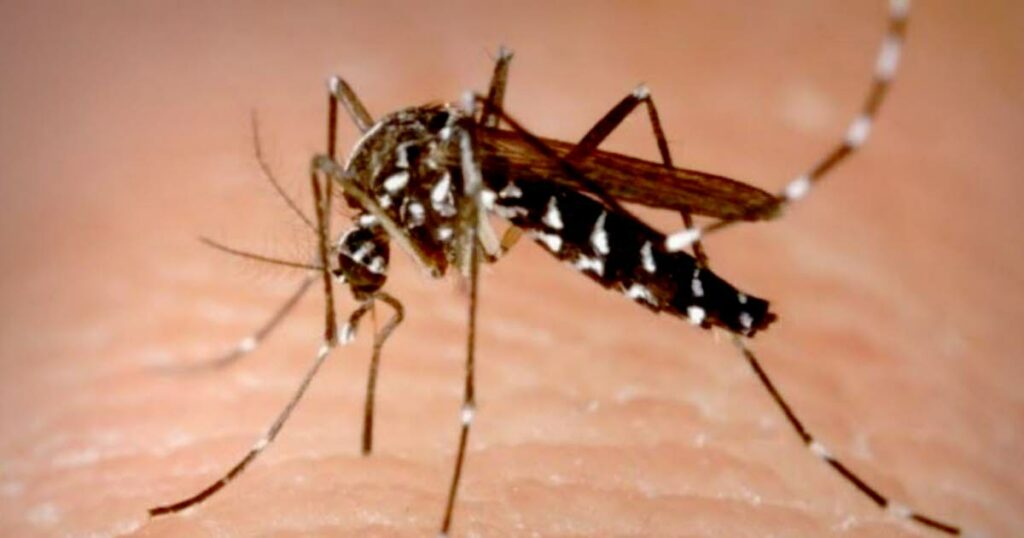The heat wave that France has been experiencing for a few days brings its share of good news, but also bad news: drought, heat wave… and invasion of mosquitoes.
One species is particularly feared: Aedes albopictus, better known as the tiger mosquito. Composite portrait of the suspect: he is from the tropical forests of Southeast Asia, he is less than 5 millimeters tall (smaller than a penny), a black and white striped body, he Bites during the day, is silent and its bite is very painful.
The tiger mosquito can be a vector of diseases such as dengue fever, chikungunya or even zika (since 2015). But it can only transmit these diseases if and only if it is contaminated.
A species present since 2004 in metropolitan France
In Auvergne-Rhône-Alpes, the invasive insect has been present since 2012. The Regional Health Agency (ARS) of the region qualifies the tiger mosquito as being « established and active » in ten departments: Ain, Ardèche, Drôme, Isère, Loire, Puy-de-Dôme, Rhône, Savoie, Haute-Savoie, and since 2020, Cantal.
As for the Provence-Alpes-Côte d’Azur region, the tiger mosquito has been present there since 2004. Along with the Occitanie region, it is the region most affected by the tiger mosquito in France. Thus, more than 62% of the municipalities are colonized and 97% of the population lives in contact with the insect.
In our departments, only Vaucluse has a percentage of colonized municipalities greater than 40% (as of January 1, 2022).
39 cases of dengue fever recorded in Auvergne-Rhône-Alpes and PACA in 2021
In 2021, 164 cases of dengue due to the tiger mosquito were recorded in France. Among them, 20 cases of dengue had been identified in Auvergne-Rhône-Alpes, while the Paca region had experienced 19 similar cases and one case of chikungunya. The vast majority of dengue cases were imported from Reunion Island (108).
With the strong heat returning, the establishment of the tiger mosquito is accelerating in all departments, even in those where it is not yet present.
Questioned by the Dauphiné Libéré at the beginning of May, the Interdepartmental Agreement for mosquito control in the Rhône-Alpes region (EID Rhône-Alpes) affirmed « all the conditions are almost met for it [le moustique-tigre, NDLR] begins to proliferate again. By the time the larvae develop, the first nuisances should be felt at the end of May, beginning of June. »
For the moment, no case of virus transmission by the tiger mosquito has been observed in metropolitan France. It is overseas that cases of disease have been declared, thanks to climatic conditions even more favorable to its proliferation (tropical climate, therefore hot and humid).
Simple steps to protect yourself from tiger mosquitoes
As more than 80% of tiger mosquitoes establish their nests on private property, the public authorities are counting on the action and vigilance of the population to eradicate the proliferation zones.
To fight against the multiplication of this highly invasive species, health authorities recommend a few simple actions:
- Remove so-called “stagnant” water, that is to say areas where water stagnates on the surface (saucers under plant pots, tarpaulins, containers left outside, etc.);
- Regularly clean gardens and terraces (especially gutters and garbage cans);
- In the most exposed areas, install mosquito nets on doors and windows and put on air conditioning;
- Wear long clothes and protect your feet and ankles.
- Impregnate your clothes with a repellent insecticide or use skin repellents (advised by your doctor or pharmacist), which will repel mosquitoes without killing them.
According to the National Health Security Agency (ANSES), the tiger mosquito bite is distinguished from other insect bites by the itching sensation which appears very quickly and intensifies for several minutes after the bite.
A blister-like blister may appear. The bite of the tiger mosquito scratches almost instantly, then the itching disappears. They can nevertheless reappear for several days in the event of a change in temperature (after a shower for example).

